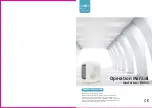
Manual 2100-353
Page
17
START UP AND OPERATION
THREE PHASE SCROLL COMPRESSOR
START UP INFORMATION
Scroll compressors, like several other types of
compressors, will only compress in one rotational
direction. Direction of rotation is not an issue with
single phase compressors since they will always start
and run in the proper direction.
However, three phase compressors will rotate in either
direction depending upon phasing of the power. Since
there is a 50-50 chance of connecting power in such a
way as to cause rotation in the reverse direction,
verification of proper rotation must be made.
Verification of proper rotation direction is made by
observing that suction pressure drops and discharge
pressure rises when the compressor is energized.
Reverse rotation also results in an elevated sound level
over that with correct rotation, as well as, substantially
reduced current draw compared to tabulated values.
Verification of proper rotation must be made at the
time the equipment is put into service. If improper
rotation is corrected at this time there will be no
negative impact on the durability of the compressor.
However, reverse operation for over one hour may have
a negative impact on the bearing due to oil pump out.
NOTE: If compressor is allowed to run in reverse
rotation for several minutes the compressor’s
internal protector will trip.
All three phase ZR*3 compressors are wired identically
internally. As a result, once the correct phasing is
determined for a specific system or installation,
connecting properly phased power leads to the same
Fusite terminals should maintain proper rotation
direction.
The direction of rotation of the motor may be changed
by reversing any two line connections to the unit.
SEQUENCE OF OPERATION
COOLING
– Circuit R-Y makes at thermostat pulling
in compressor contactor starting the compressor and
outdoor motor. The G (indoor motor) circuit is
automatically completed on any call for cooling
operation, or can be energized by manual fan switch on
subbase for constant air circulation.
HEATING
– A circuit R-W1 is completed on each
heating cycle energizing electric heat if so equipped.
START UP NOTES
For improved start up performance, wash the indoor
coil with dishwasher detergent.
INDOOR BLOWER MOTOR
Some models feature a variable speed (ECM) motor
providing high efficiency, low sound levels and soft
start capabilities. The motor is self adjusting to provide
the proper air flow rate at duct static pressures up to
0.50” WC without user adjustment or wiring changes.
On command from the wall thermostat the motor will
start slowly and ramp up to full speed over a period of
10- 15 seconds.
When the thermostat is satisfied the blower will operate
for approximately 1 minute, and then slow down and
stop.
COMPRESSOR CONTROL MODULE
The compressor control is an anti-short cycle/lockout
timer with high and low pressure switch monitoring and
alarm output.
ADJUSTABLE DELAY-ON-MAKE AND BREAK
TIMER
On a call for compressor operation the delay-on-make
period begins which will be 10% of the delay-on-break
setting. When the delay-on-make is complete and the
high pressure switch (and low pressure switch if
employed) is closed, the compressor contactor is
energized. Upon shutdown the delay-on-break timer
starts and prevents restart until the delay-on-break and
delay-on-make periods have expired.
HIGH PRESSURE SWITCH AND LOCKOUT
SEQUENCE (Standard Feature)
If the high pressure switch opens, the compressor
contactor will de-energize immediately. The lockout
timer will go into a soft lockout and stay in soft lockout
until the high pressure switch closes and the delay-on-
make time has expired. If the high pressure switch
opens again in this same operating cycle the unit will go
into manual lockout condition and the alarm circuit will
energize. Recycling the wall thermostat resets the
manual lockout.
















































